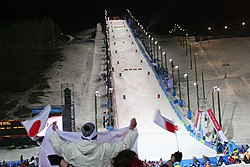Mogul skiing
 From Wikipedia - Reading time: 6 min
From Wikipedia - Reading time: 6 min
 Ruby Keefe skiing moguls at Killington Ski Resort | |
| Highest governing body | International Ski and Snowboard Federation |
|---|---|
| Characteristics | |
| Type | Freestyle skiing |
| Presence | |
| Country or region | Worldwide |
| Olympic |
|

Mogul skiing is a freestyle skiing competition consisting of one timed run of free skiing on a steep, heavily moguled course, stressing technical turns, aerial maneuvers and speed.[1] Internationally, the sport is contested at the FIS Freestyle World Ski Championships, and at the Winter Olympic Games.
Moguls are a series of bumps on a piste formed when skiers push snow into mounds as they do sharp turns. This tends to happen naturally as skiers use the slope but they can also be constructed artificially. Once formed, a naturally occurring mogul tends to grow as skiers follow similar paths around it, further deepening the surrounding grooves known as troughs. Since skiing tends to be a series of linked turns, moguls form together to create a bump field.
The term "mogul" is from the Bavarian/Austrian German word Mugel, meaning "mound, hillock".[2]
Competition
[edit]
The first competition involving mogul skiing occurred in 1971. The FIS created the Freestyle World Cup Circuit in 1980. The first World Championships were held in 1986, and are currently held in odd-numbered years. It was a demonstration sport in freestyle skiing at the 1988 Winter Olympics in Calgary. It has been a medal event in the Winter Olympics since 1992.
Mogul courses are between 200 and 270 metres with an average slope grade of 26 degrees. The moguls themselves are set approximately 3.5 metres apart. The course includes two small jumps which are used as a take-off for aerial maneuvers. Athletes can perform upright or inverted tricks off these jumps in the course of a competition run.[3] Dual Mogul competition consists of elimination rounds where pairs of competitors compete against each other. Each loser is eliminated and each winner advances to the next round until a final result is achieved.
Scoring
[edit]- Turns count for 60% of the score. This is a technical evaluation by judges, including the rhythmic changes in the direction of travel to either side of the fall line (the shortest line from start to finish), using an aggressive, controlled technique. The skier should employ carve turns, and should not skid or plow. The head should remain still, facing downhill. The chest should also stay straight and natural. Hands stay in front of the body in a natural position. Pole plants should be light and well-timed.[4]
- Air (jumps) counts for 20% of the score. Air is scored in two parts: form and difficulty. Jumps include flips, loops, rotations (helicopters/360,720), and upright jumps such as a spread eagle.[4]
- Speed counts for 20% of the score. Competitors receive a full score for speed at 10.3 m/s for women and 11.8 m/s for men.[5]
See also
[edit]References
[edit]- ^ "FIS Freestyle Skiing Scoring / Judging Handbook" (PDF). FIS. FIS. Archived from the original (PDF) on 20 February 2014. Retrieved 18 October 2014.
- ^ Moguls on My Mind by Wilhelm Grout, Skiing, November 1980, p. 24
- ^ "Disciplines". The Canadian Freestyle Ski Association (CFSA). Archived from the original on 24 October 2014. Retrieved 18 October 2014.
- ^ a b "FIS Freestyle Skiing Judging Handbook (Edition November 2014)" (PDF). FIS. Archived from the original (PDF) on 21 January 2015. Retrieved 6 December 2014.
- ^ "Archived copy" (PDF). Archived from the original (PDF) on 2024-08-08.
{{cite web}}: CS1 maint: archived copy as title (link)
 KSF
KSF